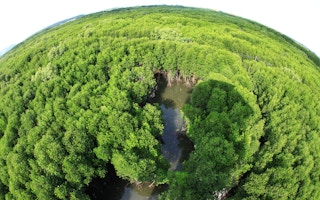Scientists have known for centuries that mangroves are one of the most carbon-rich ecosystems on Earth. Now that knowledge has been refined with the development of a map and model that pinpoint just how much carbon is stored in different mangrove areas around the world.
The discovery, published in Conservation Letters, will be of practical use because understanding this variability is critically important in developing policies and setting priorities to safeguard the carbon stores, and possibly expanding them.
The new model used by the researchers enabled them to map the variations among the world’s mangrove forests and pinpoint those areas with the most carbon.
All mangroves are important for storing carbon, but some that ranked particularly high in the study include forests in Sumatra, Borneo and New Guinea, on the Pacific coast of Colombia, and in Northern Ecuador.
Mark Spalding, principal investigator on the project and a marine scientist at the US-based worldwide conservation organisation The Nature Conservancy, says: “These results can help guide decisions regarding priority areas for the conservation and rehabilitation of mangroves for climate change mitigation.”
Laying foundations
The model is built on the work of field scientists and draws on studies from 35 countries. “This hard work on the ground by researchers lays the foundation for the task of modelling,” says the report’s lead author, James Hutchison, research assistant with the Department of Zoology’s Conservation Science Group at Cambridge University, UK.
“But it is through the combination of their many stories that we can build up a bigger picture and extrapolate to areas where no one has actually worked.”
Mangroves, like all plants, capture carbon dioxide from the atmosphere and store it in their leaves, roots and trunks (their biomass), and in the soil. However, unlike most other forests, mangrove soils do not have a maximum storage capacity, but keep on storing carbon in the soil, for centuries or even millennia.
In this way, mangroves actively contribute to mitigating climate change by continuously removing greenhouse gases from the atmosphere.
Carbon traps
Mangroves are also extremely productive ecosystems – more so than most other tropical forests. This means that they can increase their biomass faster and trap more carbon than their counterparts.
The researchers’ model indicates that mangroves contain 1.6% of the total tropical forest biomass, even though they occupy only 0.6% of the total tropical forest area.
When mangrove forests are cut down for timber, or converted to agriculture or to aquaculture ponds, almost all their carbon is released into the atmosphere. Their very high biomass means that clearing even small tracts of mangrove generates high volumes of CO2.
Spalding says: “Mangroves provide timber, fish resources and coastal protection functions worth millions of dollars. Maintaining these ecosystems is an absolute win-win strategy.”
But the mangroves are being lost far faster than most other forest types worldwide. The Nature Conservancy is working with the global not-for-profit organisation Wetlands International to document the ecosystem services provided by mangroves and to find ways to manage them that maximise those services.

















